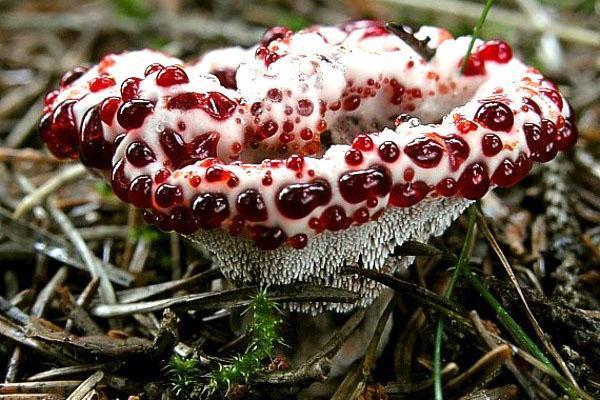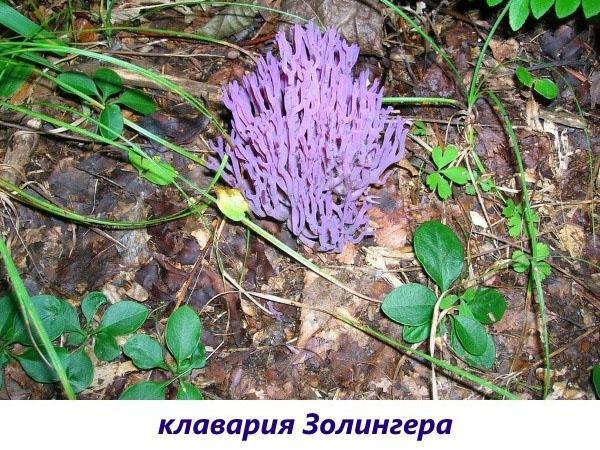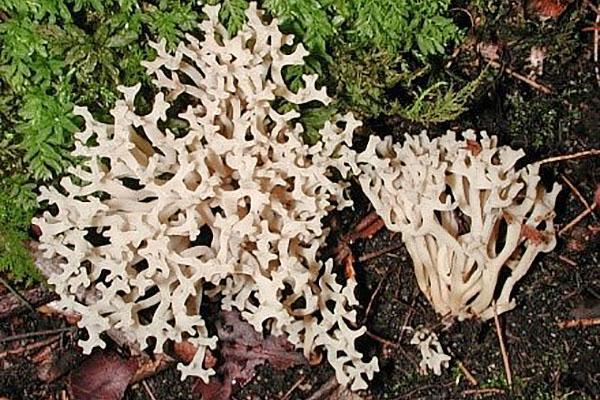Introducing unusual mushrooms that can only be admired - inedible and poisonous species of bizarre gifts of the forest
 Sometimes the outlandish form of mushrooms does not hint, but directly says that collecting them is at least pointless or even dangerous to health. Strange, albeit beautiful, shapes or the disgusting smell of the mushroom body - today we will talk about unusual mushrooms that are inedible and even poisonous. What are they and where are they found, which of them are simply tasteless, and with whom is it easy to get poisoned? We propose to stop in more detail and study the most bizarre types of mushrooms that do not represent nutritional value.
Sometimes the outlandish form of mushrooms does not hint, but directly says that collecting them is at least pointless or even dangerous to health. Strange, albeit beautiful, shapes or the disgusting smell of the mushroom body - today we will talk about unusual mushrooms that are inedible and even poisonous. What are they and where are they found, which of them are simply tasteless, and with whom is it easy to get poisoned? We propose to stop in more detail and study the most bizarre types of mushrooms that do not represent nutritional value.
Zollinger's many-sided clavaria

Clavaria zolinger in some countries is considered a rare fungus, and in the Chelyabinsk region it is generally listed in the Red Book in connection with the massive deforestation of its natural habitat.
As for the color of such bushy mushrooms, it can be very diverse, giving preference to bright colors:
- snow white;

- cream;

- lilac;

- orange;

- pink;

- purple.

For its original shape and color, the mushroom is often called coral.
Archer's Intimidating Clathrus
 At a young age, Archer's clathrus looks like a white egg with a diameter of up to 6 cm lost by someone among meadows or in mixed forests. When the mushroom "matures", the top of the egg bursts and from there, as in a terrible tale, red tentacles (recipes) crawl out. At first they are fused together, but then they open up like a flower or a star. Inside, the tentacles have dark rare spots, and they themselves are slimy and smell bad, which, however, is very popular with small insects. The mushroom has no legs, it is replaced by the lower intact part of the egg. For its unpleasant aroma and nasty fragile pulp, the mushroom is considered inedible.
At a young age, Archer's clathrus looks like a white egg with a diameter of up to 6 cm lost by someone among meadows or in mixed forests. When the mushroom "matures", the top of the egg bursts and from there, as in a terrible tale, red tentacles (recipes) crawl out. At first they are fused together, but then they open up like a flower or a star. Inside, the tentacles have dark rare spots, and they themselves are slimy and smell bad, which, however, is very popular with small insects. The mushroom has no legs, it is replaced by the lower intact part of the egg. For its unpleasant aroma and nasty fragile pulp, the mushroom is considered inedible.
The peculiar form of Archer's clathrus gave it other names, in particular, cuttlefish mushroom, Archer's flower stalker, Archer's trelliser. In the scientific literature, it can still be found under the name Anturus Archer.
Leaky mushroom clathrus red
 Much less often in the southern zone, where the climate is warm and mild, there is another type of clathrus - a red mushroom. Solar lighting does not play a special role for him, moreover, most often it is found in the dense shade of deciduous thickets. But clathrus is not able to do without heat - the mycelium of the fungus will irrevocably die if the temperature drops below 5 degrees Celsius.
Much less often in the southern zone, where the climate is warm and mild, there is another type of clathrus - a red mushroom. Solar lighting does not play a special role for him, moreover, most often it is found in the dense shade of deciduous thickets. But clathrus is not able to do without heat - the mycelium of the fungus will irrevocably die if the temperature drops below 5 degrees Celsius.
Young mushrooms are similar to Archer's clathrus and are also egg-shaped and gray-white.As the egg “ripens”, it turns red, and then the reticular membrane breaks, and openwork petals with small pores become visible. Over time, the pores expand, forming large holes-cells, as in a lattice, because of which the mushroom is also called the red lattice. There is a torn fringe along the edge of such cells. Instead of a leg, the clathrus has, as usual, the remains of an egg. It is simply impossible to confuse a mushroom with others: not only does it have an unusual shape and a bright red color, it also spreads around itself a disgusting smell of rotting meat, while you can hear it even at a distance of 15 m. However, the "aroma" attracts flies and other small insects that carry spores throughout the forest.
The red trellis is not only an unusual inedible, but also a poisonous mushroom.
Colorful trameteor multicolored
 Among the tinder fungus there is one very unusual mushroom, or rather, a mushroom with an unusual color - multicolored trametez. Outwardly, this is a quite common and well-known tinder fungus with a fan-shaped fruiting body growing on trees.
Among the tinder fungus there is one very unusual mushroom, or rather, a mushroom with an unusual color - multicolored trametez. Outwardly, this is a quite common and well-known tinder fungus with a fan-shaped fruiting body growing on trees.  However, the thin, silky and shiny caps are completely covered with circular convolutions, each of which is painted in a different color. Only the core of the cap remains monochromatic - it is most often greenish, but the most extreme strip, at the edge, is always lighter than the rest.
However, the thin, silky and shiny caps are completely covered with circular convolutions, each of which is painted in a different color. Only the core of the cap remains monochromatic - it is most often greenish, but the most extreme strip, at the edge, is always lighter than the rest.
Keeping its shape and pattern, multicolored trametez can change color, playing with a different color scheme.
 Leathery pulp smells quite nice, but it has a dense structure and does not represent nutritional value. But in folk medicine, this tinder fungus is very famous and is widely used to treat cancer, especially in Japan and China.
Leathery pulp smells quite nice, but it has a dense structure and does not represent nutritional value. But in folk medicine, this tinder fungus is very famous and is widely used to treat cancer, especially in Japan and China.
For its iridescent color, trametes are also called turkey or cuckoo's tail, as well as pestle. In the scientific literature, there are the names of coriolus multicolored or multicolored.
 You can take a closer look at the variations in the color scheme of the trameteor in the photo below.
You can take a closer look at the variations in the color scheme of the trameteor in the photo below.
Neon mycene
 In the distant rainforests of Australia, Asia, Japan and other countries with warm and humid climates, small fungi of mycene chlorophos are attracted by soft green light on the remains of trees during the rainy season.
In the distant rainforests of Australia, Asia, Japan and other countries with warm and humid climates, small fungi of mycene chlorophos are attracted by soft green light on the remains of trees during the rainy season.
 Thin, open, sticky-skinned hats emit a neon glow at night and scare tourists with a stunning and fantastic effect. The brightest light comes from mushrooms at a high temperature (at least 27 degrees Celsius) and lasts up to three days. There are no data on the edibility of the mushroom to date, but it can hardly be eaten.
Thin, open, sticky-skinned hats emit a neon glow at night and scare tourists with a stunning and fantastic effect. The brightest light comes from mushrooms at a high temperature (at least 27 degrees Celsius) and lasts up to three days. There are no data on the edibility of the mushroom to date, but it can hardly be eaten.
The rest of the time, in daylight, the bioluminescent mycene looks quite ordinary and inconspicuous: a simple gray cap on a thin translucent stem.
A waking nightmare or Peck's hydnellum
 The one who can be used for the scenery of horror films is the hydnellum Peck mushroom. Due to its appearance, it is better known as the devil's hedgehog, the devil's tooth, or the bleeding mushroom. A short thick leg, no more than 3 cm high, smoothly turns into a cap, which is the main "decoration": up to 10 cm in diameter, in young mushrooms it is white and velvety, with age it darkens to brown. There are pores on the entire surface of the hat, from which a scarlet-red liquid flows out and freezes on it in drops. The cork pulp is bitter, but it emits a pleasant smell reminiscent of strawberry.
The one who can be used for the scenery of horror films is the hydnellum Peck mushroom. Due to its appearance, it is better known as the devil's hedgehog, the devil's tooth, or the bleeding mushroom. A short thick leg, no more than 3 cm high, smoothly turns into a cap, which is the main "decoration": up to 10 cm in diameter, in young mushrooms it is white and velvety, with age it darkens to brown. There are pores on the entire surface of the hat, from which a scarlet-red liquid flows out and freezes on it in drops. The cork pulp is bitter, but it emits a pleasant smell reminiscent of strawberry.
The bleeding mushroom takes its main food from the soil, but it is also not averse to feasting on insects, which flock to the aroma of nectar and stick in it.
Another bright mushroom is blue
 In India and New Zealand grow inedible, but very beautiful blue mushrooms. Their fragile cone-shaped caps and thin high legs are painted in a sky-blue color, and a certain pigment, azulene, which is characteristic of sea bottom inhabitants, is responsible for this. The blue mushroom grows alone, among the moss and fern, standing out beautifully against the green background.
In India and New Zealand grow inedible, but very beautiful blue mushrooms. Their fragile cone-shaped caps and thin high legs are painted in a sky-blue color, and a certain pigment, azulene, which is characteristic of sea bottom inhabitants, is responsible for this. The blue mushroom grows alone, among the moss and fern, standing out beautifully against the green background.
Rare Devil Cigar Mushroom
 The scientific name of this mushroom (Chorioactis geaster) is not easy to pronounce, so everyone calls it the devil's cigar for its peculiar shape. The young mushroom body is longitudinally elongated, almost even, with a ragged surface, colored brown and really resembles a cigar. When the mushroom is fully ripe, it opens with a loud hiss, scattering spores like ash. In this form, it already becomes like a star with 4-7 rays.
The scientific name of this mushroom (Chorioactis geaster) is not easy to pronounce, so everyone calls it the devil's cigar for its peculiar shape. The young mushroom body is longitudinally elongated, almost even, with a ragged surface, colored brown and really resembles a cigar. When the mushroom is fully ripe, it opens with a loud hiss, scattering spores like ash. In this form, it already becomes like a star with 4-7 rays.
You can meet the devil's cigar only in Texas and in some places in Japan.
Bristly mushroom scutellinia thyroid
 On rotting wood, in small families, thyroid scutellinia grows - an inedible mushroom. Orange-red concave caps no larger than a coin in diameter are decorated with long standing bristles at the edges. The flesh of the mushroom is fragile, waxy in structure.
On rotting wood, in small families, thyroid scutellinia grows - an inedible mushroom. Orange-red concave caps no larger than a coin in diameter are decorated with long standing bristles at the edges. The flesh of the mushroom is fragile, waxy in structure.
In conclusion, I would like to say that this list of unusual mushrooms, inedible and poisonous, is far from complete. Strange specimens can be found both on the territory of our country, and in other climatic zones, the climate of which leaves an imprint on their appearance and features of growth. Just remember that not everything beautiful can be touched with your hands and you certainly shouldn't put it in your basket. Better to play it safe, admire these mushrooms and walk by.